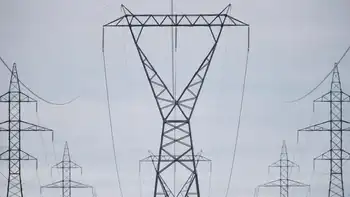Oregon mills will produce electricity from burning wood waste
O'BRIEN, OREGON - After nearly 90 years of sawing pine and Douglas fir logs into lumber, Rough & Ready Lumber Co. is branching into the energy business, building a $5 million plant to burn logging debris and to produce electricity that it can sell at a "green tag" premium to the regional power grid.
"It's ripe," said Rough & Ready President Link Phillippi, who hopes to have a 1.5 megawatt plant up and running by this fall. "There are the economic benefits, the benefits of healthy forests, and the benefit of a country needing renewable energy - clean energy."
The idea of burning wood waste - known as hog fuel - to produce energy at wood products and pulp mills is an old one that was going nowhere as long as fossil fuels were cheap, and logging was cut back to protect fish and wildlife habitat.
But leaders in the timber industry realize that energy production can help finance widespread thinning of national forests to combat wildfires and insect infestations. And the concept has a newer, catchier name, biomass energy, that helps align it with the wider movement linking economic and environmental concerns, including reducing dependence on fossil fuels.
Since Congress reauthorized a federal energy production tax credit for biomass, solar and wind power last month, at least two other sawmills in Oregon are going forward with biomass projects.
Another is slated for Arizona in conjunction with a long-term U.S. Forest Service thinning project there triggered by the massive 2002 Rodeo-Chedeski fire. More are foreseen in California, which has a long history of generating electricity from forest thinnings.
Steve Mueller, president of DG Energy LLC of San Diego, which is building a new plant in Lakeview, said there are three keys. A generating plant needs to be close to the fuel - trucking little trees much more than 35 miles is too expensive. It must be close to a major electrical transmission line. And it needs to be close to a mill to buy the excess steam. Plants burning forest thinnings and waste from lumber and pulp mills generate about 2,500 megawatts nationally - far behind wind power in production, popularity and government support - said Bill Carlson, chairman of USA biomass Power Producers Alliance.
Burning mill waste and logging debris, which formerly had gone to waste, can reduce the cost of thinning the millions of acres of national forest at high risk of catastrophic wildfire.
"We are giving the forester, the manager of the land, another economic tool to work with, whether it is to thin the forest, remove disease, or just for general economic activity," said Allyn Ford, president of Roseburg Forest Products, which already has a biomass generator at its mill complex in Dillard.
"When you compare the value of the electricity to the value of restoring the health of the forest, I would say restoring the health of the forest is at least as valuable as the energy that is produced," Carlson said.
Two things are holding it back, people in the industry say. Federal energy credits for biomass remain about half the levels for solar and wind power, something advocates hope to see corrected this year.
And the Forest Service has developed just one long-term contract for forest thinning. Without a long-term contract, developers are wary of investing millions of dollars.
"If the Forest Service got serious about this and wanted to solve 50 percent of the (forest thinning) problem over the next two decades, there might be 5,000 to 10,000 megawatts of biomass power," said Carlson.
A report for the Western Governors Association estimates biomass in the West has a potential to produce more than 10,000 megawatts - about 1 percent of the nation's production by 2015. About half would come from forest thinning. The rest from urban waste and agriculture. Spurred by the massive Rodeo-Chedeski fire of 2002, which burned 400 homes, the Apache-Sitgraves National Forest in Arizona has let a 10-year contract to thin 150,000 acres that is generating small logs for lumber, wood pellets for stoves, and fueling a 3 megawatt biomass plant, said Forest Supervisor Elaine Zieroth.
Zieroth said having buyers for the trees too small for lumber helps reduce the cost of thinning from $900 an acre to $500 an acre. If forest service officials could expand the market enough to break even, they could easily thin 800,000 acres that need it.
Future projects are being developed, but likely will remain small, geared to local needs and conditions, said Marcia Patton-Mallory, biomass coordinator for the Forest Service.
Environmentalists are wary. Although they like the idea that biomass generation can help pay for forest thinning, they want natural fire to take over once the thinning is done.
"One should not consider biomass energy sustainable or renewable," said environmental consultant Andy Kerr, who has been working to help more biomass projects get up and running. "Because for the most part, after these forests have been thinned, you don't want them to get thick again, certainly not thick enough to be economically feasible to cut the trees down and haul them to the biomass energy incinerator."
For now, the grants and tax credits make construction of a biomass plant too good to pass up, making it possible to pay back the estimated $5 million investment in four years instead of 10, said Phillippi of Rough & Ready Lumber.
"These plants were always unaffordable because of our size," said Phillippi. But with the grants and tax credits, "It looked pretty good. We went ahead and did it. We're glad we did."
Related News

UCP scraps electricity price cap, some will see $7 bill increase this month
EDMONTON - Electricity will be more expensive for some Edmontonians in December after the UCP government scrapped a program that capped rates.
Effective Nov. 30, the province got rid of the price cap program for Regulated Rate Option customers.
In 2017, the NDP government capped the kilowatt per hour price at 6.8 cents, meaning Edmontonians would pay the market rate and not more than the capped price.
In December, kWh will cost 7.5 cents. Typical Edmonton homes use an average of 600 kWh, increasing bills by $7.37, or 3.9 per cent, compared to November.
The NDP created the capacity system to bring price stability…




